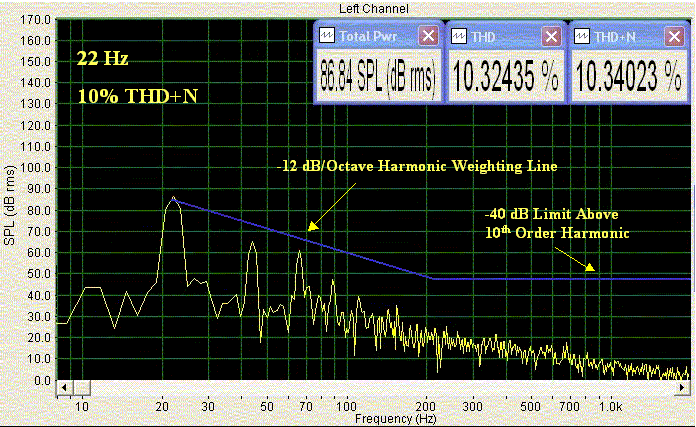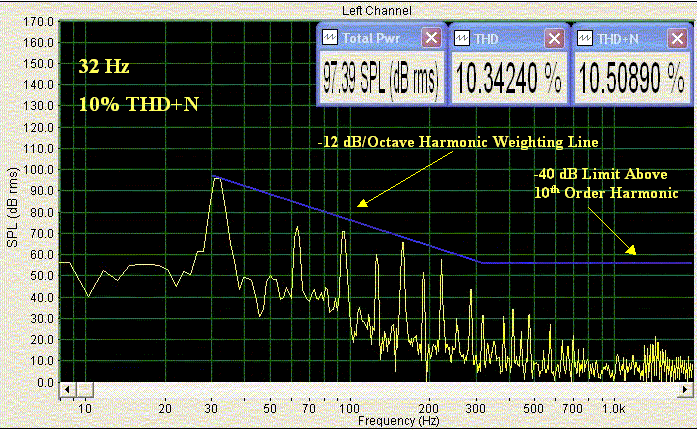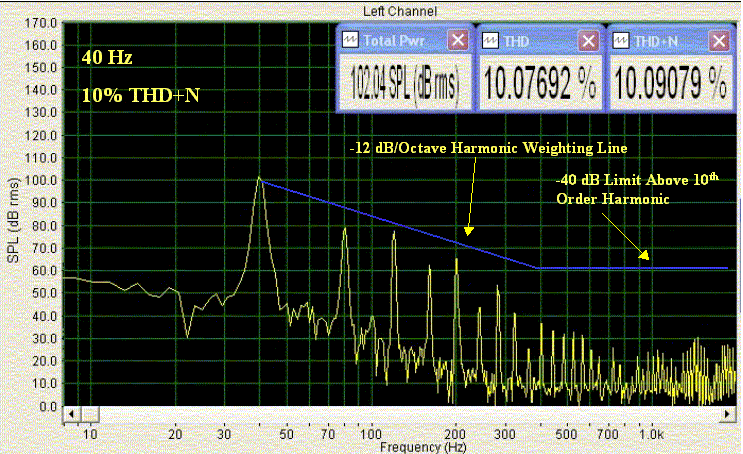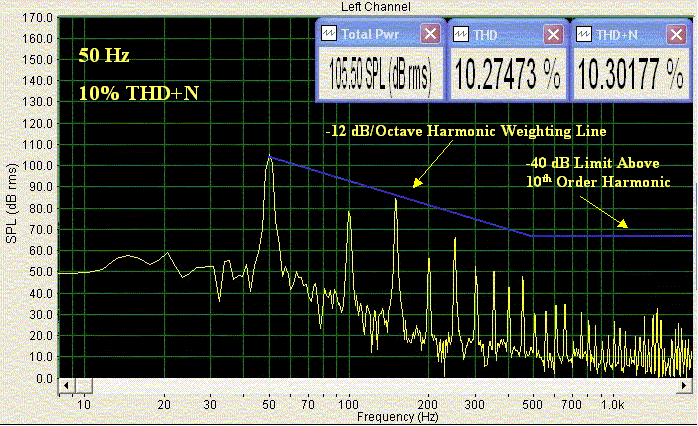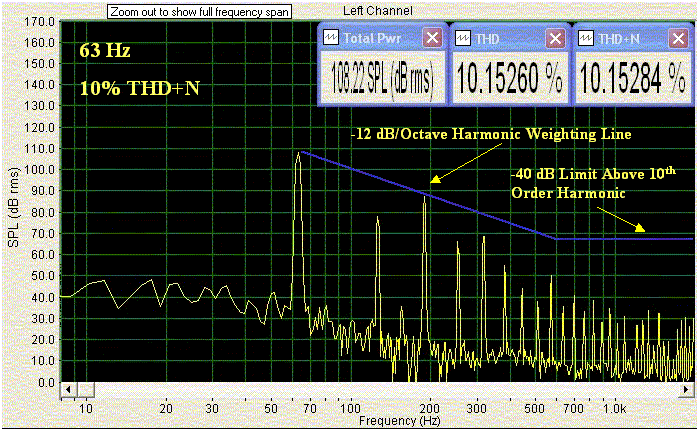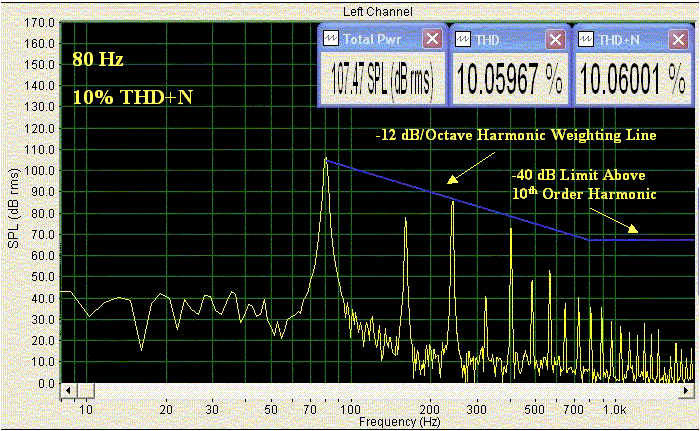|
|||||||||||||||||||||||||||||||||||||||||||||||||||||||||||||||
|
|
|||||||||||||||||||||||||||||||||||||||||||||||||||||||||||||||
|
Frequency (Hz) |
SPL (dB) |
THD (%) |
|
20 |
84.0 |
10.4 |
|
22 |
86.8 |
10.3 |
|
25 |
91.6 |
10.4 |
|
32 |
97.4 |
10.3 |
|
40 |
102.0 |
10.1 |
|
50 |
105.5 |
10.3 |
|
63 |
108.2 |
10.2 |
|
80 |
107.5 |
10.1 |
The average sound pressure level over various bandwidths was calculated below using the 10% THD limits from the above table. The bandwidth linearity performance is determined by dividing the average SPL by the maximum SPL, and expressing the result as a percentage. A score of 100% means the subwoofer exhibits perfect output linearity (with respect to the 10% THD limits) over a given bandwidth.
|
Bandwidth (Hz) |
Average SPL (dB) |
Bandwidth Linearity |
|
20-80 |
97.9 |
90% |
|
22-80 |
99.9 |
92% |
|
25-80 |
102.0 |
94% |
|
32-80 |
104.1 |
96% |
|
40-80 |
105.8 |
98% |
For the benefit of readers interested in drawing further parallels to the CEA-2010 standard for distortion audibility in subwoofers, the average sound pressure for the 20 Hz -32 Hz bandwidth (defined as "Ultra Low Bass" in the 2010 standard), and for the 40-63 Hz bandwidth (defined as "Low Bass" in the 2010 standard) was calculated using the 10% THD limits. The equivalent sound pressure at a 1 meter test distance (a requirement of the 2010 standard) is also provided.
|
Bandwidth (Hz) |
Average SPL (dB) 2 Meter |
Average SPL (dB) 1 Meter |
Comments |
|
20-32 |
90.0 |
96.0 |
These data are similar to what would be generated by the CEA 2010 standard for the "Ultra Low Bass" rating. |
|
40-63 |
105.2 |
111.2 |
These data are similar to what would be generated by the CEA 2010 standard for the "Low Bass" rating. |
Group Delay Calculation: A sufficiently large and abrupt phase shift may cause the perception of time smearing at the affected frequencies. Group Delay (GD) is used to quantify this phenomenon, and is essentially the derivative of phase with respect to frequency. Extrapolations of existing GD studies suggest an audibility threshold of 1.0 to 1.5 cycles.
The 850 SC holds Group Delay below 1 cycle over the entire useable pass band – an impressive performance for a bass reflex design. And while GD obviously increases more rapidly below about 30 Hz, there are no abrupt changes in the slope of the curve.
Since the 850 SC GD below 1 cycle across the entire bass music spectrum, enthusiasts can expect "on-time" and coherent sound delivery from this subwoofer with popular (e.g., rock/pop/jazz) music.
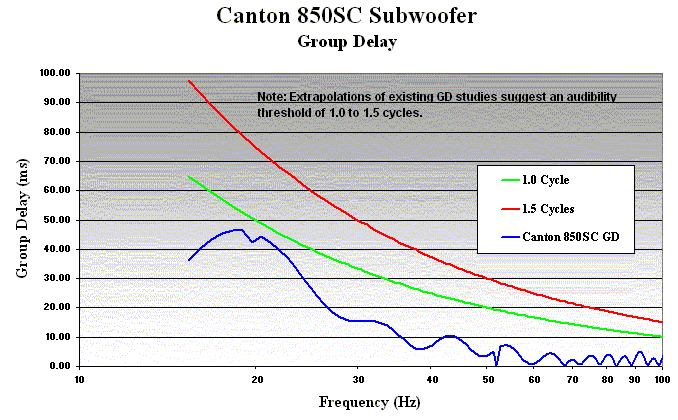
System Ringing and Stored Energy Release Test: The amount of system ringing and stored energy release exhibited by a subwoofer is a function of its acoustic alignment and roll-off profile. A subwoofer with a narrow F6 bandwidth and a steep roll-off will ring longer and release more stored energy than will a subwoofer with a wider F6 bandwidth and a shallower roll-off profile.
Most subwoofers will ring anywhere from 25-200 ms at system resonance. Similar to group delay, the audibility of system ringing and stored energy release is frequency dependent. The deeper it occurs, the less likely it will be noticeable on music and movies.
The 850 SC exhibits a very wide F6 bandwidth and a roll-off slope of 36 dB/octave below 23 Hz. This results in system ringing for only about 50 ms on the impulse response with barely any overshoot, and a very uniform and short duration spectral decay signature. This is almost perfect transient behavior, and is very rare for a bass reflex alignment.
Accordingly, listeners can expect a tight sound with minimal overhang from the 850 SC. Readers should be reminded that the listening room itself has a very large influence on perceived tightness, and that noticeable overhang is often the result of excessive modal ringing, which can often be ameliorated with bass traps.
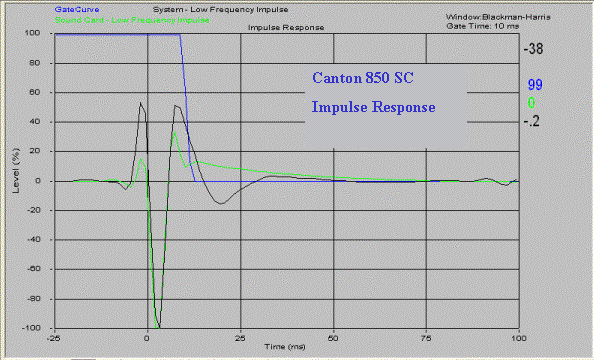
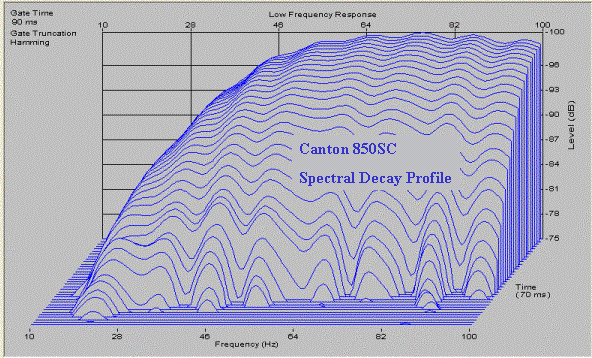
|
© Copyright 2006 Secrets of Home Theater & High Fidelity |


